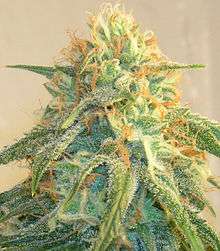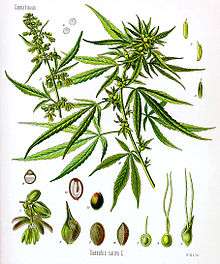Cannabis sativa
| Cannabis sativa | |
|---|---|
| | |
| Scientific classification | |
| Kingdom: | Plantae |
| (unranked): | Angiosperms |
| (unranked): | Eudicots |
| (unranked): | Rosids |
| Order: | Rosales |
| Family: | Cannabaceae |
| Genus: | Cannabis |
| Species: | C. sativa |
| Binomial name | |
| Cannabis sativa L. | |
| Subspecies | |
| |
Cannabis sativa is an annual herbaceous plant in the Cannabis genus, a species of the Cannabaceae family. People have cultivated Cannabis sativa throughout recorded history as a source of industrial fibre, seed oil, food, recreation, religious and spiritual moods, and medicine. Each part of the plant is harvested differently, depending on the purpose of its use. The species was first classified by Carl Linnaeus in 1753.[1]
Common uses
Its seeds are chiefly used to make hempseed oil which can be used for cooking, lamps, lacquers, or paints. They can also be used as caged-bird feed, as they provide a moderate source of nutrients for most birds. The flowers (and to a lesser extent the leaves, stems, and seeds) contain psychoactive chemical compounds known as cannabinoids that are consumed for recreational, medicinal, and spiritual purposes. When so used, preparations of flowers (marijuana) and leaves and preparations derived from resinous extract (e.g., hashish) are consumed by smoking, vaporizing and oral ingestion. Historically, tinctures, teas, and ointments have also been common preparations. In traditional medicine of India in particular C. sativa has been used as hallucinogenic, hypnotic, sedative, analgesic, and anti-inflammatory agent.[2]
Plant physiology
The flowers of the female plant are arranged in racemes and can produce hundreds of seeds. Male plants shed their pollen and die several weeks prior to seed ripening on the female plants. Although genetic factors dispose a plant to become male or female, environmental factors including the diurnal light cycle can alter sexual expression.[3] Naturally occurring monoecious plants, with both male and female parts, are either sterile or fertile but artificially induced "hermaphrodites" (a commonly used misnomer) can have fully functional reproductive organs. "Feminized" seed sold by many commercial seed suppliers are derived from artificially "hermaphrodytic" females that lack the male gene, or by treating the plants with hormones or silver thiosulfate. In the case of production related to recreational use of Cannabis, the process of "cloning" provides the grower with DNA identical female plants eliminating the need of seeds for the growing process.
A Cannabis plant in the vegetative growth phase of its life requires more than 12–13 hours of light per day to stay vegetative. Flowering usually occurs when darkness equals at least 12 hours per day. The flowering cycle can last anywhere between nine and fifteen weeks, depending on the strain and environmental conditions.
In soil, the optimum pH for the plant is 6.3 to 6.8. In hydroponic growing, the nutrient solution is best at 5.2 to 5.8, making Cannabis well-suited to hydroponics because this pH range is hostile to most bacteria and fungi.
Cultivars
Broadly, there are three main cultivar groups of cannabis that are cultivated today:
- Cultivars primarily cultivated for their fibre, characterised by long stems and little branching.
- Cultivars grown for seed which can be eaten entirely raw or from which hemp oil is extracted.
- Cultivars grown for medicinal or recreational purposes. A nominal if not legal distinction is often made between industrial hemp, with concentrations of psychoactive compounds far too low to be useful for that purpose, and marijuana.
Pharmacology



Although the main psychoactive constituent of Cannabis is tetrahydrocannabinol (THC), the plant is known to contain more than 500 compounds, among them at least 113 cannabinoids; however, most of these "minor" cannabinoids are only produced in trace amounts.[4] Besides THC, another cannabinoid produced in high concentrations by some plants is cannabidiol (CBD), which is not psychoactive but has recently been shown to block the effect of THC in the nervous system.[5] Differences in the chemical composition of Cannabis varieties may produce different effects in humans. Synthetic THC, called dronabinol, does not contain CBD, CBN, or other cannabinoids, which is one reason why its pharmacological effects may differ significantly from those of natural Cannabis preparations.
Chemical constituents
Beside cannabinoids, Cannabis chemical constituents include about 120 compounds responsible for its characteristic aroma. These are mainly volatile terpenes and sesquiterpenes.
- α-Pinene[6]
- Myrcene[6]
- Linalool[6]
- Limonene[6]
- Trans-β-ocimene[6]
- α-Terpinolene[6]
- Trans-caryophyllene[6]
- α-Humulene,[6] contributes to the characteristic aroma of Cannabis sativa
- Caryophyllene,[6] with which some hashish detection dogs are trained[7]
Difference between C. sativa and C. indica
Some studies indicate that, on average, Cannabis indica has higher levels of THC to CBD, whereas Cannabis sativa has higher levels of CBD compared to THC.[8] However, huge variability exists within either species, and there is an increasing discussion whether the existing paradigm of the difference between species adequately represents the variability found within the Cannabis genus.[9][10][11] There are five chemotaxonomic types of Cannabis: one with high levels of THC, one which is more fibrous and has higher levels of CBD, one that is an intermediate between the two, another one with high levels of cannabigerol (CBG), and the last one almost without cannabinoids.[12]
Cannabis strains with relatively high CBD:THC ratios are less likely to induce anxiety than vice versa. This may be due to CBD's antagonistic effects at the cannabinoid receptors, compared to THC's partial agonist effect.[13] CBD is also a 5-HT1A receptor (serotonin) agonist, which may also contribute to an anxiolytic-content effect.[14] The effects of sativa are well known for its cerebral high, while indica is well known for its sedative effects which some prefer for night time use.[14] Both types are used as medical cannabis. Indica plants are normally shorter and stockier than sativas.[15] They have broader, deeply serrated leaves and a compact and dense flower cluster. The effects of indicas are predominantly physical and sedative.
See also
References
- ↑ Greg Green, The Cannabis Breeder's Bible, Green Candy Press, 2005, pp. 15-16 ISBN 9781931160278
- ↑ Wang, L; Waltenberger, B; Pferschy-Wenzig, EM; Blunder, M; Liu, X; Malainer, C; Blazevic, T; Schwaiger, S; Rollinger, JM; Heiss, EH; Schuster, D; Kopp, B; Bauer, R; Stuppner, H; Dirsch, VM; Atanasov, AG (2014). "Natural product agonists of peroxisome proliferator-activated receptor gamma (PPARγ): a review". Biochem Pharmacol. 92 (1): 73–89. doi:10.1016/j.bcp.2014.07.018. PMC 4212005
 . PMID 25083916.
. PMID 25083916. - ↑ Schaffner, John H. (1921-01-01). "Influence of Environment on Sexual Expression in Hemp". Botanical Gazette. 71 (3): 197–219. doi:10.1086/332818. JSTOR 2469863.
- ↑ Aizpurua-Olaizola, Oier; Soydaner, Umut; Öztürk, Ekin; Schibano, Daniele; Simsir, Yilmaz; Navarro, Patricia; Etxebarria, Nestor; Usobiaga, Aresatz (2016-02-02). "Evolution of the Cannabinoid and Terpene Content during the Growth ofCannabis sativaPlants from Different Chemotypes". Journal of Natural Products. 79 (2): 324–331. doi:10.1021/acs.jnatprod.5b00949.
- ↑ Russo, Ethan B (2011-08-01). "Taming THC: potential cannabis synergy and phytocannabinoid-terpenoid entourage effects". British Journal of Pharmacology. 163 (7): 1344–1364. doi:10.1111/j.1476-5381.2011.01238.x. ISSN 1476-5381. PMC 3165946
 . PMID 21749363.
. PMID 21749363. - 1 2 3 4 5 6 7 8 9 Novak J, Zitterl-Eglseer K, Deans SG, Franz CM (2001). "Essential oils of different cultivars of Cannabis sativa L. and their antimicrobial activity". Flavour and Fragrance Journal. 16 (4): 259–262. doi:10.1002/ffj.993.
- ↑ Essential Oils
- ↑ Hillig, K. W.; Mahlberg, P. G. (1 June 2004). "A chemotaxonomic analysis of cannabinoid variation in Cannabis (Cannabaceae)". American Journal of Botany. 91 (6): 966–975. doi:10.3732/ajb.91.6.966. PMID 21653452. Retrieved 28 May 2015.
- ↑ Piomelli, Daniele; Russo, Ethan B. (2016-01-14). "The Cannabis sativa Versus Cannabis indica Debate: An Interview with Ethan Russo, MD". Cannabis and Cannabinoid Research. 1 (1): 44–46. doi:10.1089/can.2015.29003.ebr.
- ↑ Aizpurua-ppOlaizola, Oier; Omar, Jone; Navarro, Patricia; Olivares, Maitane; Etxebarria, Nestor; Usobiaga, Aresatz (2014-10-23). "Identification and quantification of cannabinoids in Cannabis sativa L. plants by high performance liquid chromatography-mass spectrometry". Analytical and Bioanalytical Chemistry. 406 (29): 7549–7560. doi:10.1007/s00216-014-8177-x. ISSN 1618-2642.
- ↑ Hazekamp, A.; Fischedick, J. T. (2012-07-01). "Cannabis - from cultivar to chemovar". Drug Testing and Analysis. 4 (7-8): 660–667. doi:10.1002/dta.407. ISSN 1942-7611.
- ↑ Mandolino, Giuseppe; Bagatta, Manuela; Carboni, Andrea; Ranalli, Paolo; Meijer, Etienne de (2003-03-01). "Qualitative and Quantitative Aspects of the Inheritance of Chemical Phenotype in Cannabis". Journal of Industrial Hemp. 8 (2): 51–72. doi:10.1300/J237v08n02_04. ISSN 1537-7881.
- ↑ 2015. "Marijuana Chemicals Cannabinoids, Terpenes, Flavonoids (THC and CBD)." Howtogrowmarijuana.com. Retrieved from http://howtogrowmarijuana.com/cannabinoids-terpenes-flavonoids-cbd-thc/.
- 1 2 J.E. Joy; S. J. Watson, Jr.; J.A. Benson, Jr (1999). Marijuana and Medicine: Assessing The Science Base. Washington D.C: National Academy of Sciences Press. ISBN 0-585-05800-8.
- ↑ Fischedick, Justin Thomas; Hazekamp, Arno; Erkelens, Tjalling; Choi, Young Hae; Verpoorte, Rob (December 2010). "Metabolic fingerprinting of Cannabis sativa L., cannabinoids and terpenoids for chemotaxonomic and drug standardization purposes". Phytochemistry. 71 (17-18): 2058–2073. doi:10.1016/j.phytochem.2010.10.001. PMID 21040939. Retrieved 28 May 2015.
External links
| Wikimedia Commons has media related to Cannabis sativa. |
-
 Data related to Cannabis sativa at Wikispecies
Data related to Cannabis sativa at Wikispecies
